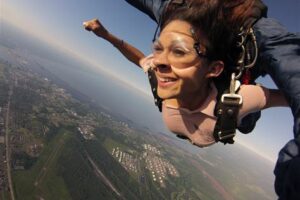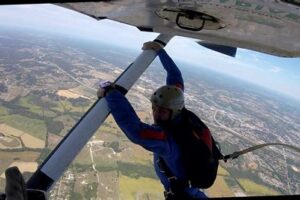Table of Contents
Curious about the safety of skydiving? Find out how many people have died from skydiving and gain insight into the risks associated with this thrilling activity. Discover statistics and facts to help you make an informed decision before taking the leap.
Skydiving, a thrilling sport that involves jumping from an aircraft and free-falling before deploying a parachute, has captivated the adventurous souls of many. The allure of soaring through the open skies, defying gravity, and experiencing an adrenaline rush like no other has made skydiving a popular choice for daredevils. However, as with any extreme sport, there is an inherent risk involved. This begs the question: How many people have tragically lost their lives pursuing this exhilarating hobby?
The Thrill and Risk of Skydiving
Skydiving is a thrilling adventure sport that entices individuals seeking an adrenaline rush and a unique experience. The sheer exhilaration of jumping out of an airplane, freefalling through the sky, and then gliding back to the ground is incomparable. However, like any extreme activity, skydiving carries inherent risks. It is natural for people to wonder about the safety of this sport and how many individuals have lost their lives pursuing this daring pastime. In this article, we will explore the statistics and provide an objective analysis of the fatalities associated with skydiving.
Understanding the Risks
Before delving into the number of fatalities, it is essential to understand the risks associated with skydiving. While modern safety measures and equipment have significantly reduced the chances of accidents, there are still inherent dangers involved. Factors such as equipment malfunction, human error, adverse weather conditions, and unforeseen circumstances can all contribute to accidents during a skydive.
The Importance of Training
Proper training is crucial in mitigating the risks associated with skydiving. Skydiving centers and organizations around the world prioritize safety and ensure that every participant receives thorough training before taking their first jump. These training programs cover various aspects, including parachute deployment, emergency procedures, body positioning, and landing techniques. By imparting the necessary knowledge and skills, training equips individuals with the tools to handle potential risks effectively.
Statistical Analysis
While skydiving may seem inherently dangerous, the statistics tell a different story. According to the United States Parachute Association (USPA), the average number of fatalities per year in the U.S. due to skydiving accidents is relatively low compared to other activities. In fact, the fatality rate has been steadily declining over the years. The USPA reports that out of approximately 3.3 million jumps made annually, there are an average of 21 fatal accidents, resulting in roughly 0.0064% of jumps leading to a fatality.
Factors Influencing Fatalities
Several factors can contribute to fatalities in skydiving accidents. One common cause is human error, often resulting from poor decision-making or failure to follow proper procedures. Equipment malfunction, although rare due to regular maintenance and rigorous safety checks, can also pose a risk. Additionally, adverse weather conditions, such as strong winds or storms, can increase the likelihood of accidents. While these factors may increase the risk, it is crucial to note that the majority of skydives are completed without any incidents.
Ongoing Safety Improvements
The skydiving community is continuously striving to enhance safety measures and reduce the risk of accidents. Advances in equipment technology, parachute design, and training techniques have significantly contributed to improving skydiving safety. Rigorous inspections, maintenance protocols, and implementation of standardized safety procedures ensure that participants can enjoy the sport while minimizing the chances of accidents.
Comparing Skydiving to Other Activities
When evaluating the safety of skydiving, it is essential to consider the risk associated with other everyday activities. While skydiving may seem extreme, the fatality rate is often lower than that of several routine activities, such as driving a car or riding a motorcycle. This perspective highlights the relative safety of skydiving when proper precautions are taken.
The Importance of Responsible Skydiving
Though the statistics indicate that skydiving is relatively safe, it is crucial for participants to engage in responsible and cautious practices. Following all safety guidelines, receiving proper training, and selecting reputable skydiving centers are fundamental in ensuring a safe experience. Skydiving is an adventure that should be enjoyed with respect for the sport and an understanding of the risks involved.
Conclusion
Skydiving is an exhilarating activity that captivates individuals seeking excitement and adventure. While there are inherent risks associated with this extreme sport, the number of fatalities is relatively low compared to the number of jumps made each year. The skydiving community places a paramount focus on safety by providing thorough training, improving equipment, and implementing strict protocols. By embracing responsible practices and understanding the risks involved, individuals can enjoy this thrilling pursuit with a greater sense of confidence and security.
Introduction to Skydiving Safety Records
Skydiving is an exhilarating activity that attracts adventure seekers from all walks of life. While it offers an adrenaline rush like no other, concerns about safety frequently arise. In this article, we will explore the number of people who have tragically lost their lives while participating in this extreme sport.
Understanding the Statistics
Accurate statistics regarding skydiving fatalities can be challenging to obtain due to variations in reporting methods across different regions and countries. However, records compiled by reputable organizations provide valuable insights into this subject matter. It is important to interpret the numbers with caution, considering factors such as experience level, training quality, equipment maintenance, and weather conditions.
Global Skydiving Fatalities
In recent years, the global average number of skydiving fatalities has been approximately 0.006% of all jumps, which translates to roughly one death for every 160,000 jumps. While this figure may initially seem alarming, it is crucial to remember that skydiving is a high-risk activity, and the vast majority of jumps are completed without incident.
Safety Regulations and Their Impact
The implementation of stringent safety regulations and standards has significantly contributed to reducing skydiving fatalities over the years. Requirements such as mandatory training programs, licensed instructors, and regular equipment inspections aim to ensure safety and prevent accidents. These regulations have undoubtedly played a critical role in reducing the number of tragic incidents.
Factors Influencing Fatality Rates
Multiple factors influence the fatality rates in skydiving. Experience level and training are paramount, as inexperienced skydivers are more likely to encounter difficulties while mastering the sport. Weather conditions also play a crucial role, as adverse weather can increase the risks associated with skydiving. It is important to consider these factors when assessing skydiving safety.
Skydiving Fatalities: Categories and Trends
Skydiving fatalities can be divided into different categories based on the cause of death, such as parachute-related accidents, mid-air collisions, or landing mishaps. Analyzing the trends in these categories allows for a better understanding of the areas where improvements in safety protocols should be focused. Continuous research and analysis play an essential role in preventing future accidents.
Regional Disparities in Fatalities
Fatalities in skydiving can vary significantly from one region to another. These differences can be influenced by factors such as local regulations, safety standards, and the overall popularity of the sport. It is essential for skydiving enthusiasts to be aware of these disparities when choosing a drop zone and to ensure that safety measures are rigorously followed, regardless of the location.
Conclusion and Promoting Safe Practices
Skydiving, like many other extreme sports, inherently carries risks. However, with the implementation of proper safety measures, including quality training, adherence to regulations, and regular equipment maintenance, the number of fatalities has been minimized. Understanding the statistics, analyzing trends, and promoting safe practices are paramount to ensuring the continued enjoyment of skydiving while keeping participants as safe as possible.
Skydiving is an exhilarating adventure that attracts thrill-seekers from all walks of life. While it offers an unparalleled rush and a unique perspective of the world, it is important to acknowledge the potential risks associated with this extreme sport. Skydiving accidents do occur, and unfortunately, some individuals have lost their lives pursuing this adrenaline-fueled activity.
1. Statistically Low Fatality Rate:
It is crucial to put skydiving fatalities into perspective. According to the United States Parachute Association (USPA), an organization that oversees skydiving safety, the fatality rate for skydiving is remarkably low. In fact, the USPA reports an average of 0.006 fatalities per 1,000 jumps, which translates to a 0.0006% chance of dying while skydiving. These statistics indicate that skydiving is generally a safe activity when proper precautions are taken.
2. Importance of Training and Preparation:
One of the primary reasons behind skydiving accidents is inadequate training or poor preparation. It is crucial for individuals to receive comprehensive training from certified instructors before attempting their first jump. Proper training equips skydivers with the necessary knowledge and skills to handle emergency situations effectively. Additionally, ensuring that all equipment is in excellent condition and undergoing regular maintenance is essential to minimize the risk of accidents.
3. Human Error as a Contributing Factor:
Like any other sport, human error can play a significant role in skydiving accidents. In some cases, fatalities occur due to poor decision-making or reckless behavior. It is imperative for skydivers to adhere strictly to safety protocols and exercise sound judgment throughout their jumps. Maintaining situational awareness, following established procedures, and avoiding unnecessary risks can greatly reduce the possibility of accidents and fatalities.
4. Continuous Improvement in Safety Measures:
The skydiving industry is committed to enhancing safety measures and mitigating risks. Over the years, advancements in parachute technology, equipment design, and safety protocols have significantly contributed to reducing the number of fatalities. Organizations like the USPA work tirelessly to establish and enforce strict safety guidelines, ensuring that all skydiving operations meet rigorous standards. Continuous improvement and adherence to these safety measures are crucial for minimizing the risks associated with this extreme sport.
5. Individual Responsibility and Informed Consent:
Ultimately, the decision to partake in skydiving lies with the individual. It is important for prospective skydivers to understand and accept the risks involved before participating in this activity. By acknowledging the inherent dangers and taking personal responsibility for their safety, individuals can make informed decisions about whether skydiving is right for them.
In conclusion, while skydiving does carry certain risks, the fatality rate remains relatively low when compared to other activities. With proper training, preparation, and adherence to safety guidelines, skydiving can be a thrilling and safe experience. It is vital for individuals to be aware of the potential dangers and take responsibility for their own safety, ensuring that skydiving remains an enjoyable and rewarding adventure for all who choose to pursue it.
Thank you for taking the time to visit our blog and read our article on the topic of How Many People Have Died From Skydiving. We hope that you found the information provided both informative and insightful. As we conclude this discussion, it is important to summarize the key points and provide a final perspective on the subject matter.
Firstly, it is crucial to acknowledge that skydiving is an extreme sport that inherently carries some level of risk. However, it is essential to put these risks into perspective. According to statistics, the number of fatalities resulting from skydiving accidents is relatively low compared to other activities. While any loss of life is tragic, the fatality rate in skydiving has been steadily decreasing over the years due to advancements in safety measures and training protocols.
Furthermore, it is important to note that the majority of skydiving accidents occur due to human error or violations of safety regulations, rather than equipment failure. This emphasizes the significance of proper training, adherence to safety guidelines, and the use of reliable gear. By following these precautions, individuals can significantly reduce the chances of accidents and ensure a safer skydiving experience.
In conclusion, while there have been unfortunate incidents resulting in fatalities within the skydiving community, it is crucial to remember that the sport is continuously evolving to enhance safety standards. The number of deaths related to skydiving is relatively low compared to other activities, and the industry’s commitment to improving training and equipment further reduces the risks involved. So, if you are considering skydiving or are already an enthusiast, it is vital to stay informed, take the necessary precautions, and trust in the safety measures put in place to enjoy this thrilling adventure responsibly.
We hope this article has provided you with valuable insights and a better understanding of the risks associated with skydiving. Thank you again for your visit, and we encourage you to explore our other blog posts for additional engaging content. Safe travels and happy reading!
Video How Many People Have Died From Skydiving
Here are some common questions that people also ask about how many people have died from skydiving:
-
Is skydiving dangerous?
Skydiving, like any extreme sport, carries inherent risks. However, when proper safety protocols are followed and equipment is well-maintained, the risk of fatalities is relatively low. The United States Parachute Association (USPA) estimates that the fatality rate for skydiving is approximately 0.006 fatalities per 1,000 jumps.
-
How many people die from skydiving each year?
The exact number of deaths from skydiving varies from year to year. According to the USPA, there were 15 skydiving-related fatalities out of about 3.3 million jumps in the United States in 2019. This equates to a fatality rate of approximately 0.0045%.
-
What are the main causes of skydiving fatalities?
The most common causes of skydiving fatalities include canopy malfunctions, improper landings, and human error. Canopy malfunctions occur when the parachute fails to open correctly or encounters issues during descent. Improper landings can lead to severe injuries if not executed properly. Human error, such as failure to follow safety procedures or misjudgment during the jump, can also contribute to accidents.
-
Are tandem skydives safer than solo jumps?
Tandem skydives, where a certified instructor is attached to the participant, are generally considered safer than solo jumps. This is because the instructor handles most of the technical aspects of the skydive, allowing the participant to enjoy the experience without having to worry about deploying the parachute or controlling the descent. Tandem jumps have a lower fatality rate compared to solo jumps.
-
What precautions can be taken to minimize the risks of skydiving?
To minimize the risks associated with skydiving, it is important to choose a reputable skydiving center that follows strict safety protocols. Make sure the instructors are certified and experienced. Additionally, always check the condition of the equipment before jumping and follow all instructions provided during the training session. Being physically fit and mentally prepared can also contribute to a safer skydiving experience.
Remember, while there are risks involved in skydiving, following proper procedures and receiving training from professionals can help mitigate those risks and ensure a safe and enjoyable experience.






